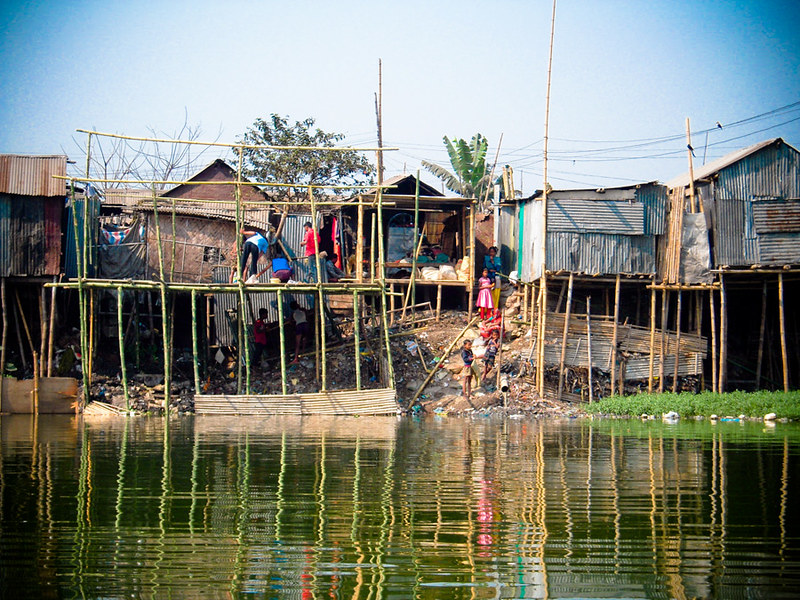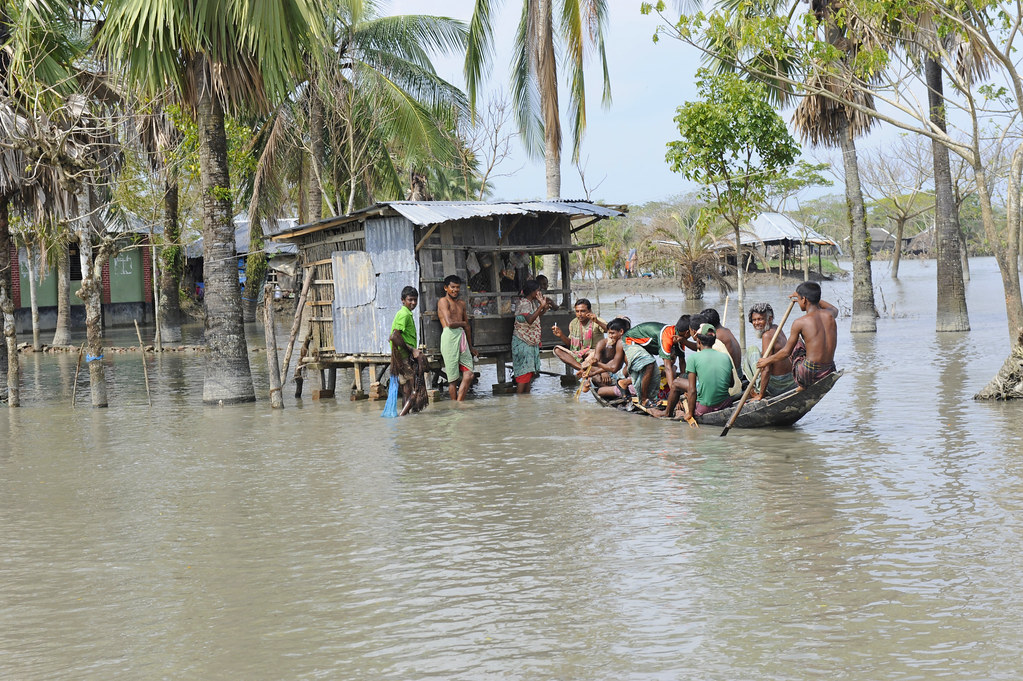
This monsoon season, Bangladesh experienced its worst flooding since 2004. Over seven million people in the north-eastern region of Sylhet have been affected, with floods damaging 185,000 acres of paddy fields and 741,000 acres of other crops, including maize, jute, and vegetables. This is in addition to the loss of lives, and the damage to property and infrastructure. Bangladesh has always been dependent on its water resources. Its location demands it, as it is situated on the lower regions of river basins, where the weather is characterized by monsoon rain. In this delta region, the basins of four major rivers converge — the Ganges, Brahmaputra, Jamuna, and Meghna. Therefore, during years of peak rainfall, water flow has been tremendous and has inundated substantial areas of the nation. Considering Bangladesh’s high vulnerability to climate change, it is worthwhile considering where Dhaka sits on the broad spectrum of climate geopolitics and what steps the country can consider to navigate the challenges posed by the climate crisis in the years to come.
Climate Geopolitics and Bangladesh
When the Paris Agreement on climate change came into being, member countries agreed on an international framework to limit global warming to well below 2°C and pursue efforts to limit it to 1.5°C. The aim of this accord was also to strengthen the ability of countries to deal with the impacts of climate change and to support each other in their efforts. The Sixth Assessment Report (AR6) of the UN’s Intergovernmental Panel on Climate Change (IPCC) projects that if the world simply proceeds on a ‘business as usual’ basis against the 1.5°C temperature goal, there will be irreversible consequences. The compounded impacts of climate change and a global pandemic have brought us to a time when alarming terms, such as ‘planetary emergency’, are realities we have to live with, accept, and learn how to tackle.
For the realization of the Paris climate goals, it is imperative for Bangladesh to explore the possibilities of new pathways to achieve national targets.
According to the World Bank, climate-related disasters affected nearly 700 million people across South Asia in the past decade — meaning roughly half of the region’s population. In 2014, the Asian Development Bank estimated that unchecked climate change could knock off 9 percent of South Asia’s GDP. Bangladesh’s development trajectory is hampered not only by the global climate crisis and contextual realities like the COVID-19 pandemic, but also by the influx of over a million Rohingya refugees from neighboring Myanmar in recent years.
Even if countries have started implementing the Paris Agreement obligations diligently, the world will still experience a 3.2°C temperature increase by the end of this century. The countries that are bearing the brunt of climate change are small island nations and densely populated countries. Bangladesh falls in the latter group, in addition to having a big coastal region in the Bay of Bengal. Over the years, the country has come up with various adaptation strategies, including installing more than six million solar-home systems in off-grid areas, distributing over 4.5 million improved cooking stoves in rural areas, and even canceling plans to build ten coal-based power plants worth USD 12 billion of foreign investment. Yet, many challenges remain.

Next steps for Bangladesh
Bangladesh has taken large strides to combat the climate crisis with its own resources. It has established its own national Bangladesh Climate Change Trust Fund (BCCTF), with a budget of USD 447 million between the Fiscal Years 2009-10 to 2019-20. As Bangladesh takes steps to reach middle-income status, by graduating from least developed countries (LDC) status, it means there would be an end to its reliance on its development partners, such as Japan and other OECD countries. For the realization of the Paris climate goals, it is imperative for Bangladesh to explore the possibilities of new pathways to achieve national targets, which includes reducing carbon emissions by 89.47 million tons, equal to roughly 22 percent of carbon dioxide output by 2030. This target will be achieved by cutting about 96 percent emissions from the energy sector, such as power, transport, industry, households, commercial, agriculture, brick kilns, and fugitive emissions. The remaining approximate 4 percent is to be eliminated from agriculture and livestock, forestry, and municipal solid waste and wastewater.
An interesting initiative the country is considering is building model towns to house climate-change migrants. Over the years, Bangladesh has developed a model town in its southern region of Mongla to provide employment and accommodation for those affected by climate change. In the near future, Bangladesh can try to implement this model in other areas of the country. This, for starters, will help address rural to urban migration to cities like Dhaka and Chittagong, which already have to deal with a high population density and a lack of access to jobs, shelter, and food, and bear the major burden of hosting climate-change migrants.
Additionally, not building infrastructure in locations that can exacerbate flooding is also important. For example, climate-change experts have blamed the impact of the ongoing floods in the country’s Sylhet division partly on the destruction of traditional wetlands, known as ‘haors’. A haor is a saucer-shaped shallow depression, which, during the monsoon, receives surface runoff from rivers and canals, and absorbs excess rainwater. Over the years, various types of infrastructure, including roads, have been constructed on Sylhet’s haors, thereby obstructing the flow of water.
Furthermore, the country needs a multi-stakeholder approach for development. It is important to mainstream climate change into developmental processes via inter-country interoperability, by which context-specific information can be exchanged for agro-tech, digi-tech, and fin-tech solutions. This is complex, but it can open doors for greater regional cooperation, such as with South Asian Association for Regional Cooperation (SAARC) neighbors, including Sri Lanka and the Maldives, which are also disproportionately vulnerable to rising sea levels.
Finally, Bangladesh needs the global community to know more about its plight and requires more publicity. During past catastrophes, the victims of sudden and highly publicized catastrophes, like the 2004 Asian tsunami or the 2005 US Gulf Coast hurricanes, benefitted from mobilizations of the private and public sector. Yet, around the same time, the 2004 Bangladesh floods did not get much publicity. As a result, the total assistance to 2004 tsunami victims was estimated to be around USD 7,100 per affected person, while the victims of the 2004 Bangladesh floods received just USD 3.00 per affected person. In 2009, Maldivian President Mohamed Nasheed held the world’s first underwater cabinet meeting, in a symbolic cry for help to draw attention to the imminent demise of his island nation because of rising sea levels. This was one of the most successful publicity stunts to date, bringing global attention to the plight of low-lying small island states. Perhaps, in the near future, Bangladesh can orchestrate something as creative in order to garner the world’s attention.
Editor’s Note: A version of this piece was originally published on 9DashLine, and has been republished with permission of the editors.
***
Image 1: Development Planning Unit University College London via Flickr
Image 2: Water Alternatives Photos via Flickr


